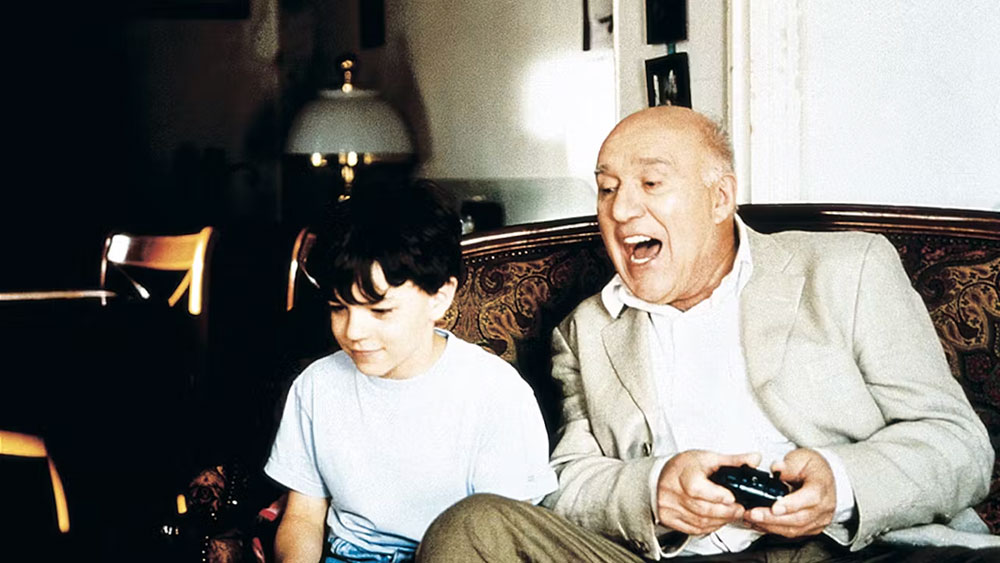The first, and often only, thing most cinephiles know about the Portuguese filmmaker Manoel de Oliveira is that he reached the impressive age of 106. His career spanned 84 years, from the semi-silent city symphony Working on the Douro River (1931), to the CGI-era with The Strange Case of Angelica (2010) and Gebo and the Shadow (2012). The latter two he directed in his 100s. Age is just a number, as the saying goes, and Oliveira’s age is largely important for two reasons. First, because it gives us a sense of the scale and breadth of an oeuvre that frequently questioned the fundamentals of the art form, whether it be through his own idiosyncratic uses of film grammar or through his frequent forays into adaptation, in which his obsessive textual fidelity often led him toward a pure cinema composed of an ascetic tableau style that was matched with performances drained of naturalism and emotion. Secondly, because it invokes a living link to the past; in his cinema, it is as if the origins of cinema itself—dating all the way back to the Lumière Brothers and Georges Méliès—are still a living presence in the 21st century. There is a Proustian dimension to how the past informs much of Oliveira’s work, remaining tantalizingly remote and yet incessantly present. His first explicit look back at his life came in his mid-70s with Visit, or Memories and Confessions (1982), which was made on the occasion of him leaving his family home and withheld from release until after his death in 2015. After making Visit, or Memories, his reflections on death and memory became many. By the time of I’m Going Home (2001), mortality had become a wholly natural theme in his films, unimposing and stripped of all nostalgia.
I’m Going Home is the story of an aging actor, Gilbert Valence (Michel Piccoli), dealing with the death of his wife and child. The film portrays the grieving process free of sentimentality; not as a raging torment, but as another stage of life that we resign ourselves to as we grow older. We first encounter Valence performing as King Berenger in Eugène Ionesco’s Exit the King. He is sobbing uncontrollably, back turned toward the theater audience (and camera), refusing to accept his own death in the play. However, when he is informed of his family’s passing after the curtain call, the moment is quiet and delivered completely offscreen. We neither see nor hear his reaction, we merely glimpse him rushing from the theater in the background of a wide shot. A title card then declares some time has passed before cutting to a brief moment of Valence staring at an old photo. After that, the deaths go quietly unstated for much of the rest of the film.
Most of I’m Going Home consists of the ordinary: Valence sitting in a café reading a leftist newspaper; Valence buying shoes; Valence stopping to stare at a painting in a store window; Valence marveling at the newly-constructed ferris wheel commemorating the new millennium. Oliveira films most of this in his typical tableau style, largely eschewing camera movement for a relaxed and airy sense of ordinariness that accentuates textural details over drama. For example, during an important conversation between Valence and his agent (Antoine Chappey) where the latter implores Valence to date again, Oliveria spends the majority of the conversation in a sustained medium-wide shot of the pair’s feet underneath the table, only showing their faces at the end of the scene. It’s a mystifying choice that deemphasizes any psychological or dramatic identification in favor of images and motifs that are poetically resonant while remaining free of symbolism.
For Oliveira, who often spoke against the ingrained notion of film as a primarily visual medium, it is also a way of emphasizing the aural textures of performance. A later scene of Valence rehearsing a film adaptation of James Joyce’s Ulysses demonstrates this line of aesthetic experimentation even more beautifully. Oliveira shoots the whole scene as a close-up on the face of the director (John Malkovich) while he sits next to the camera, allowing us to only hear Valence’s performance from off-screen as we take in the director’s reactions. With every nervous lick of the lips, or uneasy downward glance to the script, Malkovich not only draws our attention to the deficiencies we hear in Valence’s uncertain performance, but also contrasts it with his own relaxed performance and the profundities of his nuanced micro-gestures. Oliveira, in one simple shot, breaks down the various component parts of cinematic performance—sound, image, character, naturalism, dialogue, physicality—and turns them all into questions for us to ponder over.
Oliveira was a filmmaker who resisted the notion that one should tell the audience what to think or feel, and subsequently one gets a great sense of discovery while watching I’m Going Home. Narrative events slowly accumulate even if the plot often feels stationary. But it is always the small moments, like Valence playing with his grandson or pretending he’s asleep so as to not answer the phone, that have an unexpected monumentality to them. A tidal wave of emotion does eventually come crashing down at the end of the film, suddenly illuminating the deep pathos behind the most mundane images and throwing the entire film into relief. Even here, however, it is what is unsaid, unseen, and just barely hinted at that is most haunting.
I’m Going Home screens this afternoon, March 29, and on April 2, at BAM as part of the series “Mirror of Life: Manoel de Oliveira 1996 - 2004.”


